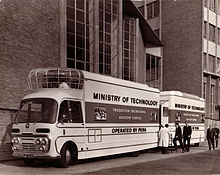- Mobile cinema
-
A mobile cinema is a cinema on wheels.
An example is the Screen machine Mobile Cinema of Scotland, which provides conventional up-to-date 35mm screenings of recent movies, with full digital surround sound, air conditioning, comfortable raked seating, and full disabled access. The French have their own Cinemobile system. There are also smaller mobile cinemas employing digital projection technology. Examples of these include the Gorilla Cinema solar powered mobile cinema established in 2000, which uses solar power and batteries to enable projection in even more remote locations, often taking place outdoors at night or housed in marquees and other temporary structures, and more recently the mobile cinema world has seen the relaunch of a recently restored 1967 custom built mobile cinema unit (see 'History' below).
In Italy since 2006 mobile cinema for two viewers Cortomobile projects short films and animations in cinema festivals[1] and has been protagonist of the First Car Film Festival (Florence) in March 2009.
Since 1995 Cinetransformer International of Miami Florida USA has circulated a fleet of mobile cinema units for use in event and experiential marketing. With a patented stadium style configuration of 91 seats, the Cinetransformer debuted as the world's first 3D mobile cinema at Comic Con in 2010 with the release of Jackass 3 In 3D, it was chosen again in 2011 to debut Final Destination 5 In 3D.
Contents
History
During the Russian Civil War between Communists and counter-revolutionaries, the early cinema pioneer Dziga Vertov helped establish and run a film-car on Mikhail Kalinin's agit-train. He had equipment to shoot, develop, edit, and project film. The trains went to battlefronts on agitation-propaganda missions intended primarily to bolster the morale of the troops; they were also intended to stir up revolutionary fervor of the masses.
In the late 1960s, Tony Benn, working under Harold Wilson's Labour government, commissioned seven custom built mobile cinema units for the Ministry of Technology campaign to 'raise standards' and promote British industry. The project was short lived and the units were sold off at government auction in 1974, most are thought to have been long since decommissioned and disappeared. However, one has survived via purchase by Sir William McAlpine to tour with the Flying Scotsman locomotive he rescued from America, and consequently donated to the Transport Trust in 1975 where it was in preservation for 15 years. It has since been through several private owners and following a full restoration is now in operation as Vintage Mobile Cinema, based in the South West of England.
Mobile cinema was very popular during the colonial periods in Africa when Landrovers were used as movie vans to transport a white linen screen, usually mounted on the Landrover, a portable generator, a 16mm projector and mounted loudspeakers. In this way rural areas received propaganda and educational films, usually shown in the evenings during dark hours. In the UK a mobile Solar powered cinema was launched in 2010. The Sol Cinema uses an LED projector showing short films in cinematic surroundings. They use lithium batteries to store the energy from the Sun to power the cinema all day and night. Their 3 photovoltaic panels harness the sunlight, even as the films are being shown so they never run out of power.
In Ireland, mobile cinemas operated from the 1920s to the mid 1960s, a portable wooden structure was erected, with seating for up to 250 people. The building had wooden sides and a canvas roof, approximately 40ft by 24ft. The 35mm projector was housed in a caravan at one end of the building. There were up to 20 families touring Ireland, mainly in isolated areas where the nearest permanent cinema was miles away. These mobile cinemas stayed up to 3 weeks in a village before moving to another area. The families lived in caravans had their own generators and a stock of films with them. During the war transport became difficult as fuel for the motor vehicles was in short supply so some cinemas settled down for the duration of the war, whilst others reverted to horses to move their equipment from village to village and saved their fuel to run the generators even then they had to buy extra fuel on the black market. The children of the showmen went to the local national schools for the duration of their stay, some went to 16 - 18 schools a year. The arrival of TV ended these mobile cinemas however they will be remembered for bringing cinema to the people in isolated areas. The names of some of these families are well remembered:- The Lyons family, The Mullens, Cullens, McCormacs, Courtneys, Lynns, McFaddens, Barrets, Corvinos and Lyns In 1949 one of these families was featured in the Times Pictorial, a Cork paper.
Notes
- ^ Jessica Goethals; "Film in motion finds its way through Florence." The Florentine.net, November 2, 2006
References
- Screen Machine Mobile Cinema - A Brief History.
- Gorilla Cinema Mobile Cinema
- Road Movie Mobile Cinema
- Vintage Mobile Cinema
External links
Categories:- Film and video terminology
- Film terminology stubs
Wikimedia Foundation. 2010.


